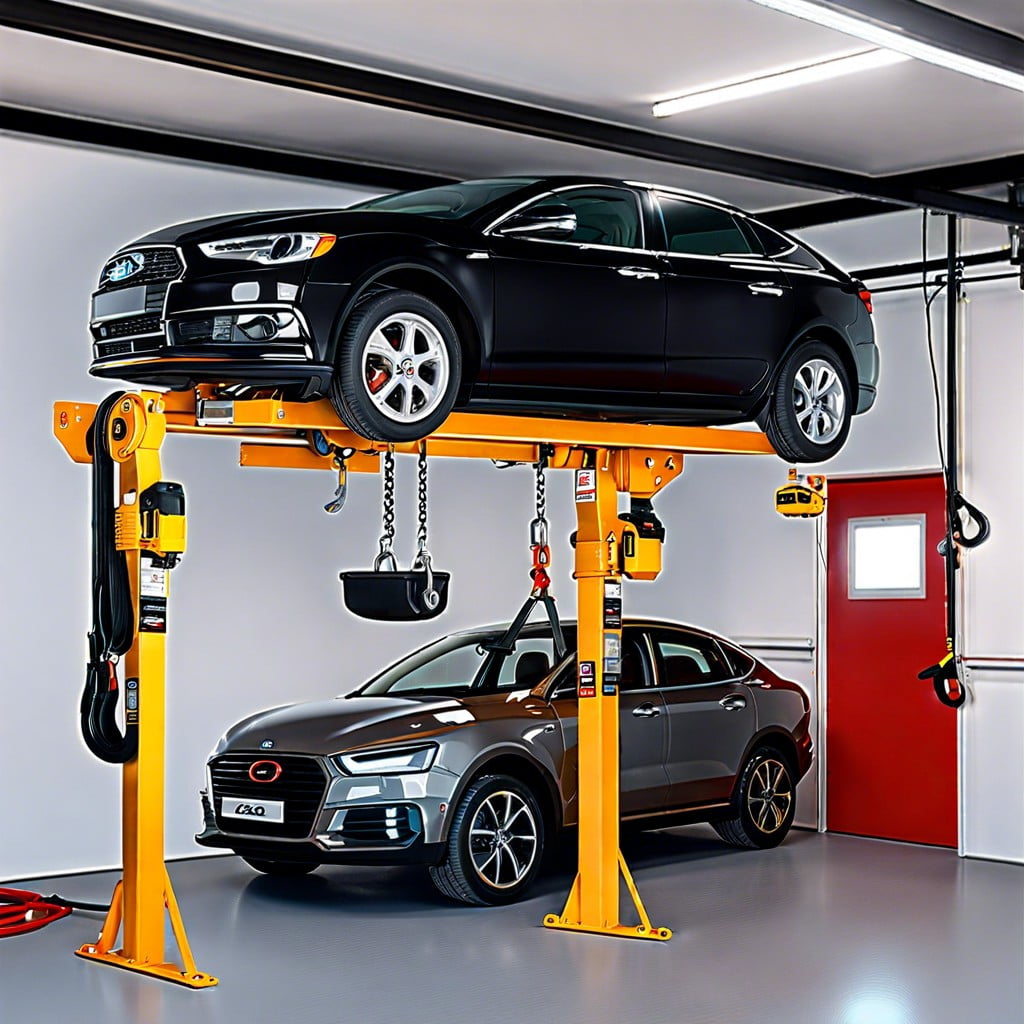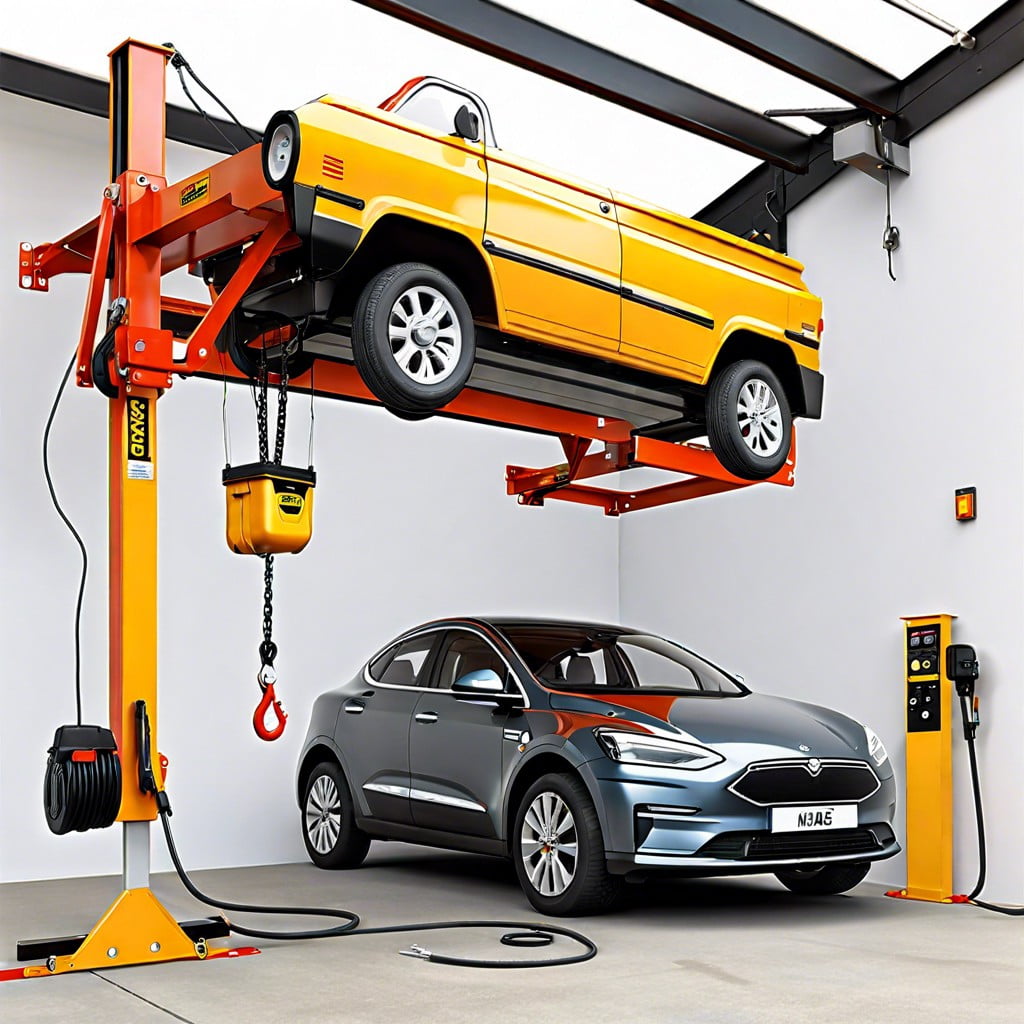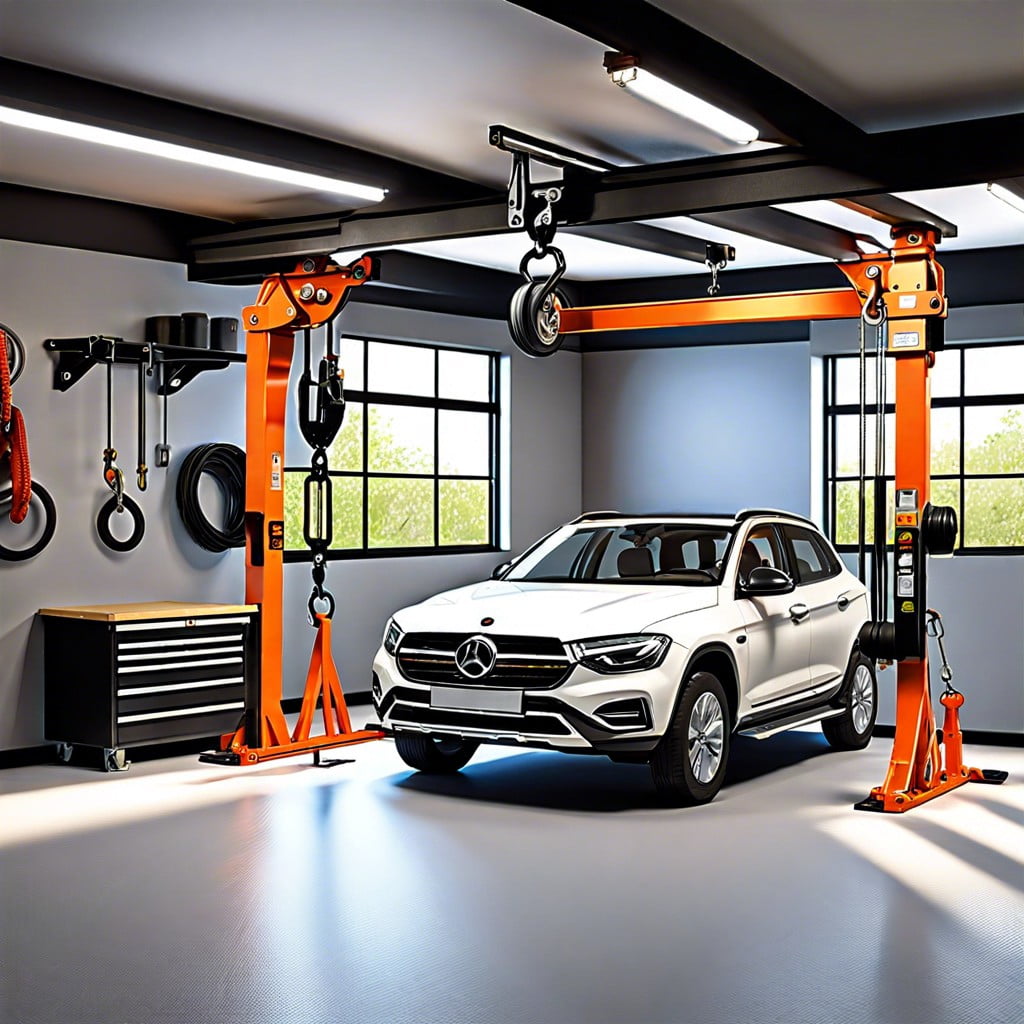Investing in a garage hoist enhances your garage’s functionality by optimizing storage space, because it easily lifts and stores heavy items out of your way.
Key takeaways:
- Manual, electric, and lever hoists are the main types available.
- Manual chain hoists are portable and low maintenance, but not ideal for heavy loads.
- Electric hoists offer convenience and variable lifting speeds.
- Lever hoists are versatile and suitable for heavy-duty tasks.
- Consider weight capacity, lifting height, power source, and safety features when choosing a garage hoist.
Garage Hoist Types

Manual chain hoists operate via a hand chain, allowing you to lift heavy items with minimal mechanical advantage. They’re a budget-friendly option and require no power source, ideal for occasional, light- to medium-duty lifting.
Electric hoists are equipped with a motor, simplifying the task of lifting heavier items. They offer a significant step up in convenience and lifting capacity compared to manual options, and are suited for frequent use or when lifting very heavy objects.
Lever hoists provide a ratcheting lever and are used for both lifting and pulling objects. They’re versatile, portable, and can be used in any orientation, making them excellent for tasks not strictly limited to vertical lifting.
Manual Chain Hoists

For simpler operations and budget-friendly solutions, consider a manual chain hoist. This type relies on human effort, with the operator pulling on a chain to lift or lower a load. They are ideal for spaces without access to power or for users who prefer an unplugged approach.
Key benefits include their portability and low maintenance, since they have fewer moving parts than electric models. However, keep in mind the physical demands; while they’re effective for occasional use or light loads, manual hoists may not be the best choice for heavy or frequent lifting.
Planning for a manual chain hoist means ensuring you have the appropriate overhead beams to support the weight and that users are capable of exerting the necessary force safely. Moreover, even with manual hoists, inspecting the chain for wear and tear is a must to ensure reliable operation over time.
Electric Hoists

Ideal for lifting heavy items with minimal effort, electric hoists are a staple in modern garages. They feature a motor that drives the lifting mechanism, drastically reducing manual labor.
Here’s what you should consider:
- Weight Capacity: Ensure the model you choose can handle the maximum weight you plan to lift.
- Power Source: Typically, these hoists require a 110V power supply, but some may need a higher voltage.
- Control: Look for models with a remote control for added safety and convenience, allowing you to operate the hoist from a safe distance.
- Speed: Electric hoists can offer variable lifting speeds, which is beneficial for precision work.
- Durability: Opt for models with a robust construction and a motor designed for continuous use.
- Noise Level: Some electric hoists operate more quietly than others, a consideration if noise is a concern in your workspace.
Remember, the initial investment for electric models may be higher than manual options, but the ease of use and time savings can be significant, especially for frequent or heavy lifting tasks.
Lever Hoists

Lever hoists offer a portable and versatile solution for lifting, pulling, and positioning loads in your garage. They’re operated by a ratcheting lever handle, which allows you to control the tension and position with precision.
Particularly useful for smaller, confined spaces, these tools are a favorite for engine lifting or positioning equipment on workbenches. They come in various capacities, usually ranging from 1/4 ton to 9 tons, meaning there’s a size to suit almost any task you have in mind.
Their compact design and ease of use make them an excellent choice for occasional, heavy-duty tasks, without the need for a permanent setup. Key features to pay attention to include the length of the lever handle, which affects leverage, and the quality of the hook and latch mechanisms, which ensure the safety and security of the suspended load.
Selecting a Garage Hoist
When choosing the right hoist for your garage, consider the weight capacity carefully. Match the hoist’s capacity with the heaviest object you plan to lift to ensure a safe working environment.
Examine the lifting height required; taller ceilings will demand a hoist with a longer chain or cable to reach the full height.
The power source is another crucial aspect. Manual hoists are economical and don’t require electricity, making them suitable for occasional use. Electric models offer convenience and are ideal for frequent lifting.
Ensure there’s a compatible power outlet or consider a battery-powered option if cable management is of concern.
Additionally, evaluate the space where you’ll install the hoist. Ensure adequate clearance around the area to facilitate unobstructed operation.
Remember, purchasing a hoist with the correct specifications is instrumental in optimizing your workflow and maintaining safety standards.
Weight Capacity
Understanding the weight capacity of a garage hoist is critical to ensure safe and effective operation. When selecting a hoist, match its rated capacity with the heaviest items you plan to lift. Overloading can risk mechanical failure and pose significant safety hazards.
It’s important to note that the hoist’s capacity might sometimes exceed that of the mounting surface or the installation hardware. Always confirm that your garage’s structure can handle the load by consulting a structural engineer if necessary.
Additionally, consider the weight distribution of the item being lifted. Uneven loads can affect performance and safety, so balanced rigging is essential for optimal hoist use.
Lifting Height
Understanding lifting height is critical when choosing a garage hoist. It determines how high an item can be raised from the ground, which impacts the overall functionality and usability of the hoist.
Here are essential points to consider:
- Measurement: Before purchasing, measure the distance from the floor to the ceiling where the hoist will be installed. This will aid in selecting a hoist with sufficient maximum lift.
- Clearance: Account for the space needed above the hoisted items for safe operation. Ensure that the lifted item does not contact ceiling fixtures or the roof.
- Adjustability: Some hoists come with adjustable lift heights, offering versatility for different tasks or items of varying sizes.
- Obstructions: Be mindful of potential obstructions in the lift path like lights, garage door tracks, or shelving and choose a hoist that aligns with your space’s layout.
Selecting the appropriate lifting height enhances the hoist’s effectiveness and ensures a safer work environment in your garage.
Power Source
Electric hoists are typically powered by standard household current, whereas pneumatic hoists rely on compressed air.
Consider the availability of electrical outlets and the ease of running power to your hoist’s location.
For an electric model, ensure the electrical circuit can handle the amperage draw.
If opting for a pneumatic hoist, a compatible air compressor is necessary.
Manual hoists require no power source, making them ideal for areas where electricity or compressed air is not accessible.
Garage Hoist Safety Features
Equipping a garage hoist with robust safety features is paramount to prevent accidents and ensure secure operation. Integrated brake systems are fundamental, ensuring that the hoist can hold a load in position the moment lifting ceases, thereby preventing backsliding.
Load limiters play a critical role as well; they automatically prevent the hoist from lifting beyond its safe working load capacity, which protects both the user and the equipment from overloading.
In addition, an emergency stop function adds an extra layer of safety, allowing for the immediate cessation of all hoist operation in the event of a problem.
These mechanisms, when combined with the user’s adherence to operational guidelines, create a safer environment for handling heavy loads in the garage space.
Brake Systems
Brake systems are integral to the safe operation of garage hoists. They provide the necessary control to halt and secure a load at any point during lifting or lowering. The most common type is the friction brake, which engages automatically when tension is released from the hoist’s controls. This serves as a fail-safe, ensuring the load doesn’t plummet dangerously if the operation is accidentally interrupted.
Another key feature in some hoists is the dynamic braking system. Instead of using physical friction, it utilizes the motor’s electrical resistance to slow down the drum’s rotation, offering smoother operation and reducing wear on the components.
Users should routinely check brake pads for wear and ensure the braking mechanism is free from dust and debris. Swift responsiveness when operating the controls is indicative of a well-maintained brake system. If any delay or slippage is noticed, it’s crucial to cease hoist operation and inspect the brake system immediately, as this is a vital safety component whose failure could result in injury or damage.